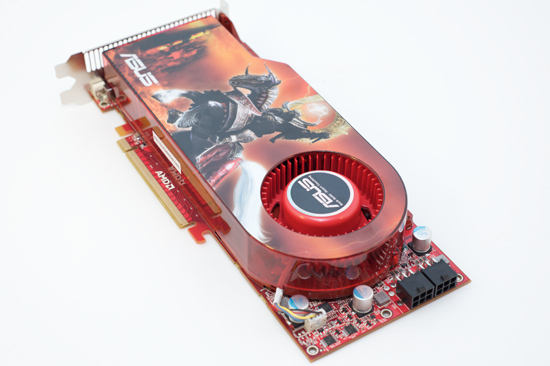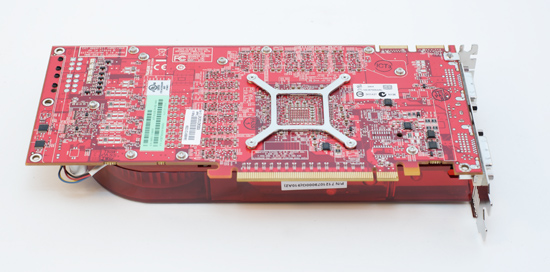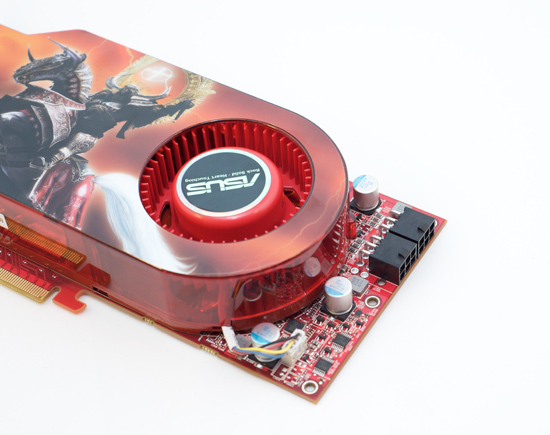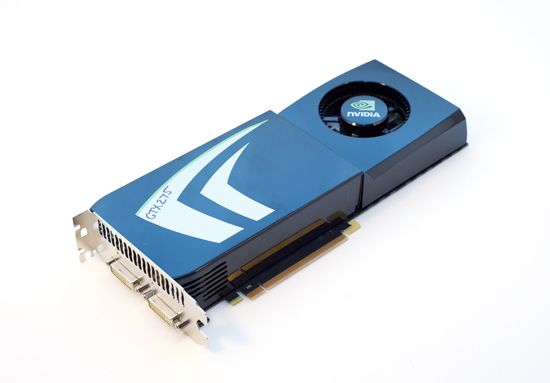ATI Radeon HD 4890 vs. NVIDIA GeForce GTX 275
by Anand Lal Shimpi & Derek Wilson on April 2, 2009 12:00 AM EST- Posted in
- GPUs
The Cards and The Test
In the AMD department, we received two cards. One was an overclocked part from HIS and the other was a stock clocked part from ASUS. Guess which one AMD sent us for the review. No, it's no problem, we're used to it. This is what happens when we get cards from NVIDIA all the time. They argue and argue for the inclusion of overclocked numbers in GPU reviews when it's their GPU we're looking at. Of course when the tables are turned so are the opinions. We sincerely appreciate ASUS sending us this card and we used it for our tests in this article. The original intent of trying to get a hold of two cards was to run CrossFire numbers, but we only have one GTX 275 and we would prefer to wait until we can compare the two to get into that angle.



The ASUS card also includes a utility called Voltage Tweaker that allows gamers to increase some voltages on their hardware to help improve overclocking. We didn't have the chance to play with the feature ourselves, but more control is always a nice feature to have.

For the Radeon HD 4890 our hardware specs are pretty simple. Take a 4870 1GB and overclock it. Crank the core up 100 MHz to 850 MHz and the memory clock up 75 MHz to 975 MHz. That's the Radeon HD 4890 in a nutshell. However, to reach these clock levels, AMD revised the core by adding decoupling capacitors, new timing algorithms, and altered the ASIC power distribution for enhanced operation. These slight changes increased the transistor count from 956M to 959M. Otherwise, the core features/specifications (texture units, ROPs, z/stencil) remain the same as the HD4850/HD4870 series.
Most vendors will also be selling overclocked variants that run the core at 900 MHz. AMD would like to treat these overclocked parts like they are a separate entity altogether. But we will continue to treat these parts as enhancements of the stock version whether they come from NVIDIA or AMD. In our eyes, the difference between, say, an XFX GTX 275 and an XFX GTX 275 XXX is XFX's call; the latter is their part enhancing the stock version. We aren't going to look at the XFX 4890 and the XFX 4890 XXX any differently. In doing reviews of vendor's cards, we'll consider overclocked performance closely, but for a GPU launch, we will be focusing on the baseline version of the card.
On the NVIDIA side, we received a reference version of the GTX 275. It looks similar to the design of the other GT200 based hardware.

Under the hood here is the same setup as half of a GTX 295 but with higher clock speeds. That means that the GTX 275 has the memory amount and bandwidth of the GTX 260 (448-bit wide bus), but the shader count of the GTX 280 (240 SPs). On top of that, the GTX 275 posts clock speeds closer to the GTX 285 than the GTX 280. Core clock is up 31 MHz from a GTX 280 to 633 MHz, shader clock is up 108 MHz to 1404 MHz, and memory clock is also up 108 MHz to 2322. Which means that in shader limited cases we should see performance closer to the GTX 285 and in bandwicth limited cases we'll still be faster than the GTX 216 because of the clock speed boost across the board.
Rather than just an overclock of a pre-existing card, this is a blending of two configurations combined with an overclock from the two configurations from which it was born. And sure, it's also half a GTX 295, and that is convenient for NVIDIA. It's not just that it's different, it's that this setup should have a lot to offer especially in games that aren't bandwidth limited.
That wraps it up for the cards we're focusing on today. Here's our test system, which is the same as for our GTS 250 article except for the addition of a couple drivers.
The Test
| Test Setup | |
| CPU | Intel Core i7-965 3.2GHz |
| Motherboard | ASUS Rampage II Extreme X58 |
| Video Cards | ATI Radeon HD 4890 ATI Radeon HD 4870 1GB ATI Radeon HD 4870 512MB ATI Radeon HD 4850 NVIDIA GeForce GTX 285 NVIDIA GeForce GTX 280 NVIDIA GeForce GTX 275 NVIDIA GeForce GTX 260 core 216 |
| Video Drivers | Catalyst 8.12 hotfix, 9.4 Beta for HD 4890 ForceWare 185.65 |
| Hard Drive | Intel X25-M 80GB SSD |
| RAM | 6 x 1GB DDR3-1066 7-7-7-20 |
| Operating System | Windows Vista Ultimate 64-bit SP1 |
| PSU | PC Power & Cooling Turbo Cool 1200W |










294 Comments
View All Comments
Lonyo - Thursday, April 2, 2009 - link
I haven't checked the benchmark numbers yet, but you list Forceware 185's on the NV side, and Cat 8.12's on the AMD side.Any reason why you are using brand new drivers for one side and 4 set old drivers on the other?
Sure, NV might not support a card on older drivers etc, but it's more useful to see newest driver vs newest driver, since there are performance changes from 8.12's to 9.3's in various games, but it just seems silly to use 3+ month old drivers which have been superseded by 3 revisions already. Would anyone buy a brand new card and then use drivers from 3~4 months ago?
Gary Key - Thursday, April 2, 2009 - link
The setup chart has been updated. We utilized previous test results from the HD4870 with the 8.12 HotFix drivers. The HD 4890 results were with the 9.4 beta drivers. I just went through a complete retest of the HD4870 with the 9.3 drivers and just started with the 9.4 betas on the AMD 790FX and Intel P45/X58 platforms. Except for a slight performance improvement in Crysis Warhead on the P45/X58 systems, the 9.3 drivers offered zero performance improvements over the 8.12 HotFix. The 9.3 drivers do offer a few updated CF profiles and improved video playback performance, but that is it.Nfarce - Thursday, April 2, 2009 - link
"the 9.3 drivers offered zero performance improvements over the 8.12 HotFix."Not only that, but if you read the ATI forums, a lot of people have been having MAJOR problems with 9.2 & 9.3. I downloaded 9.1 for my new 4870 build and have had no problems.
SiliconDoc - Monday, April 6, 2009 - link
Now now, ati doesn't have any driver problems, so don't you DARE go spreading that lie. You hear me ?Hundreds of red roosters here have NEVER had a driver problem with their ati cards.
Shame shame.
Rhino2 - Monday, April 13, 2009 - link
Stop posting, seriously, you're stupidity is causing me pain.SiliconDoc - Thursday, April 23, 2009 - link
Another personal attacker without a single counterpoint to the many lies I've exposed. Good job brainwashed fool.Frallan - Thursday, April 2, 2009 - link
Thanx - good to know.StormyParis - Thursday, April 2, 2009 - link
The Inq or The Reg is pretty adamant about the 275 being there just to spoil the 4890 launch, but never really in stores, and reviewers getting special hi-specs, hi-overclock hand by nVidia instead of the manufacturers.Did your card come from an anonymous purchase, or was it a special review sample ?
Gary Key - Thursday, April 2, 2009 - link
We mentioned in the article that we received a review sample from NVIDIA. The clock speeds are the same as the retail cards that should start arriving later next week with widespread availability around the week of 4/13. Our retail review samples will arrive early next week.As we stated several times in the article, this is a hard launch for AMD and yet another paper launch for NVIDIA, although according to the board partners the GTX275 is coming quickly this time around.
evilsopure - Thursday, April 2, 2009 - link
I also feel confused and somewhat misled by the conclusion that the GTX275 is "the marginal leader at this new price point of $250".That conclusion doesn't seem true outside of resolutions of 2560x (30" monitor). Plus, $250 cards aren't even targeted or seriously considered for gaming at that resolution.
I came up with a different conclusion after thoroughly reading this review:
At the $250 price point and 1680x or 1920x gaming resolutions (where these cards primarily matter), the 4890 holds the majority performance advantage. However, at 2560x the GTX275 performs a bit better than the 4890. Realistically though, at 2560x or on 30+" displays, you're best served by a dual GPU or SLI/Xfire solution.
Something's fishy about the reviewers' conclusion.